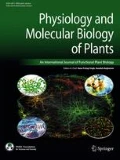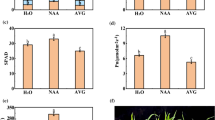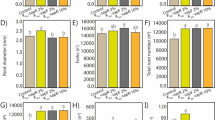Abstract
The effect of potassium nitrate on the status of fermentative and sucrose metabolizing pathways was studied in two maize (Zea mays L.) genotypes, viz., LM 5 (relatively susceptible to flooding) and I 167 (relatively tolerant to flooding) under water logging stress. The higher increase in pyruvate decarboxylase, alcohol dehydrogenase and aldehyde dehydrogenase activities in the hypoxic roots of I 167 seedlings over LM 5 showed the former’s efficient tolerance mechanism towards anaerobic conditions. Foliar application of KNO3 reduced these enzymatic activities in the roots of both the genotypes. The shoots of I 167 seedlings also showed a parallel increase in alcohol dehydrogenase and pyruvate decarboxylase activities under water logging stress. These enzymatic activities, however, remained unaffected in shoots of water logged LM 5 seedlings. There was a higher decrease in acid and alkaline invertase activities in the hypoxic roots of I 167 seedlings. KNO3 treatment led to higher acid invertase activity in roots of I 167 seedlings than those of LM 5. Sucrose synthase (synthesis) and sucrose phosphate synthase activities decreased, but sucrose synthase (breakdown) activity increased in the roots of both the genotypes, during water logging. KNO3 increased sucrose synthesizing activities with a parallel increase in the sucrose content of the roots. Sucrose synthesis was comparatively unaffected in I 167 shoots under water logging stress while LM 5 shoots showed higher reduction in its sucrose synthase (synthesis) and sucrose phosphate synthase activities. It may thus be concluded that KNO3 induced a network of reactions for improving water logging tolerance. The nitrate ions acted as an alternate electron acceptor and thus reduced the activities of fermentative enzymes. It promoted the funneling of sugars into the glycolytic pathway by inducing the activities of acid and alkaline invertases in the roots and shoots of maize genotypes. It also directed the hexoses towards biosynthetic pathway by increasing the activities of sucrose synthesizing enzymes.




Similar content being viewed by others
References
Aggarwal PK, Kalra N, Chander S, Pathak H (2006) Infocrop: a dynamic simulation model for the assessment of crop yields, losses due to pests, and environmental impact of agro-ecosystems in tropical environments. I. Model description. Agric Syst 89:1–25
Bouny M, Saglio P (1996) Glycolytic flux and hexokinase activities in anoxic maize root tips acclimated by hypoxic pretreatment. Plant Physiol 111:187–194
Carvalho PAD, Oliveria LEMD, Domiciano D, Carvalho JND, Prodente DDO, Guimaraes RJ (2018) Effect of nitrogen source and oxygen deficiency on carbon metabolism and antioxidant system of rubber tree plants (Hevea spp.). Aust J Crop Sci. https://doi.org/10.21475/ajcs.18.12.01.pne774
Crawford RMM, Braendle R (1996) Oxygen deprivation stress in a changing environment. J Exp Bot 47:145–159
Commichau FM, Forchhammer K, Stulke J (2006) Regulatory links between carbon and nitrogen metabolism. Curr Opin Microbiol 9:167–172
Dey PM (1986) Changes in the foms of invertase during germination of mungbean. Phytochemistry 25:51–53
Dubois M, Gilles KA, Hamilton JK, Robers PA, Smith F (1956) Colorimetric method for determination of sugars and related substances. Anal Chem 28:350–356
Gascon S, Lampen JO (1968) Purification of the internal invertase of yeast. J Biol Chem 243:1567–1572
Habibzadeh F, Sorooshzadeh A, Pirdashti H, Modarres-Sanavy SAM (2013) Alleviation of waterlogging damage by foliar applications of nitrogen compounds and tricyclazole in canola. Aust J Crop Sci 7:401–406
Hossain MA, Uddin SN (2011) Mechanisms of water logging tolerance in wheat: morphological and metabolic adaptations under hypoxia or anoxia. Aust J Crop Sci 5:1094–1101
Irfan M, Hayat S, Hayat Q, Afroz S, Ahmad A (2010) Physiological and biochemical changes in plants under water logging. Protoplasma 241:3–17
Jain R, Singh SP, Singh A, Singh S, ChandraA SS (2016) Response of foliar application of nitrogen compounds on sugarcane grown under water logging stress. Sugar Tech 18:433–436
Kato-Naguchi H (2000) Evaluation of the importance of lactate for the activation of ethanolic fermentation in the lettuce in anoxia. Plant Physiol 109:28–33
Kaur K, Gupta AK, Kaur N (2007) Effect of water deficit on carbohydrate status and enzymes of carbohydrate metabolism in seedlings of wheat cultivars. Indian J Biochem Biophys 44:223–230
Ke D, Yahia E, Mateos M, Kader AA (1994) Ethanolic fermentation of Bartlett pears as influenced by ripening stage and atmospheric composition. J Am Soc Hort Sci 119:976–982
Kerr PS, Kalt-Torres W, Huber SC (1987) Resolution of two molecular forms of sucrose-phosphate synthase from maize, soyabean and spinach leaves. Planta 170:515–519
Klein D, Morcuende R, Stitt M, Krapp A (2000) Regulation of nitrate reduction expression in leaves by nitrate and nitrogen metabolism is completely overridden when sugars fall below a critical level. Plant, Cell Environ 23:863–871
Kuai J, Chen Y, Wang Y, Meng Y, Chen B, Zhao W, Zhou Z (2016) Effect of water logging on carbohydrate metabolism and the quality of fiber in cotton (Gossypium hirsutum L.). Plant Sci. https://doi.org/10.3389/fpls-2016.00877
Kumutha D, Sairam RK, Ezhilmathi K, Chinnusamy V, Meena RC (2008) Effect of water logging on carbohydrate metabolism in pigeon pea (Cajanus cajan L.): upregulation of sucrose synthase and alcohol dehydrogenase. Plant Sci 175:706–716
Lawlor DW (2002) Carbon and nitrogen assimilation in relation to yield: mechanisms are the key to understanding production systems. J Exp Bot 53:773–787
Liu F, Cui X, Horner HT, Weiner H, Schnable PS (2001) Mitochondrial aldehyde dehydrogenase activity is required for male fertility in maize. Plant Cell 13:1063–1078
Manik SMN, Pengilley G, Dean G, Field B, Shabala S, Zhou M (2019) Soil and crop management practices to minimize the impact of water logging on crop productivity. Front Plant Sci 10:140. https://doi.org/10.3389/fpls.2019.00140
Nelson N (1944) A photometric adaptation of the Somogoyi method for the determination of glucose. J Biol Chem 153:375–380
Ren B, Zhang J, Li X, Fan X, Dong S, Liu P, Zhao B (2014) Effects of water logging on the yield and growth of summer maize under field conditions. Can J Plant Sci 94:23–31
Rocha M, Licausi F, Arau jo WL, Nunes-Nesi A, Sodek L, Fernie AR, Van Dongen JT (2010) Glycolysis and the tricarboxylic acid cycle are linked by alanine aminotransferase during hypoxia induced by water logging of Lotus japonicas. Plant Physiol 152:1501–1513
Sasidharan R, Hartman S, Liu Z, Martopawiro S, Sajeev N, Veen HV, Yeung E, Voesenek LAC (2018) Signal dynamics and interactions during flooding stress. Plant Physiol 176:1106–1117
Sairam RK, Kumutha D, Ezhilmathi K, Deshmukh PS, Srivastava GC (2008) Physiology and biochemistry of water logging tolerance in plants. Biol Plant 52:401–412
Statista (2019) World corn production by country 2018/19. https://www.statista.comstatistics/254292/global-corn-production-by-country. Accessed 10 Sept 2019
Stitt M (1999) Nitrate regulation of metabolism and growth. Curr Opin Plant Biol 2:178–186
Tischner R (2000) Nitrate uptake and reduction in higher and lower plants. Plant Cell Environ 23:1005–1024
Zanandrea I, Alves JD, Deuner S, Goulart PDFP, Henrique PDC, Silveira NM (2009) Tolerance of Sesbania virgata plants to flooding. Aust J Bot 57:661–669
Zeng Y, Avigne WT, Koch KE (1999) Rapid repression of maize invertase by low oxygen: invertase/sucrose synthase balance, sugar signaling potential and seedling survival. Plant Physiol 121:599–608
Author information
Authors and Affiliations
Corresponding author
Ethics declarations
Conflict of interest
The authors declare that there is no conflict of interest.
Additional information
Publisher's Note
Springer Nature remains neutral with regard to jurisdictional claims in published maps and institutional affiliations.
Rights and permissions
About this article
Cite this article
Goyal, K., Kaur, K. & Kaur, G. Foliar treatment of potassium nitrate modulates the fermentative and sucrose metabolizing pathways in contrasting maize genotypes under water logging stress. Physiol Mol Biol Plants 26, 899–906 (2020). https://doi.org/10.1007/s12298-020-00779-1
Received:
Revised:
Accepted:
Published:
Issue Date:
DOI: https://doi.org/10.1007/s12298-020-00779-1




